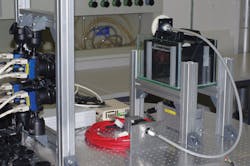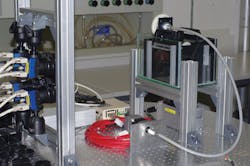Image Capture: High-speed camera system uses PTV to study crustaceans
Copepods are small crustaceans inhabiting virtually all aquatic environments, from hot hydrothermal vents to cold polar seas. Copepods of the order Calanoida usually outnumber all other marine zooplankton and represent a major food source for organisms such as fish larvae and small crustaceans. Due to their small size, copepods have limited swimming abilities and generally drift along currents in the ocean. However, on a small scale, they can move independently to capture prey, find mates, and to escape predators or unfavorable conditions.
Because environmental factors such as turbulence, salinity levels or waterborne pollutants affect their behavior, quantifying the swimming dynamics of copepods under different conditions can be used for ecological prediction and modeling of population dynamics. Because their swimming activity shows strong inter-individual variability, a large number of long trajectories are required to gain statistically relevant data.
To meet these challenges, Dr. François-Gaël Michalec, a postdoctoral researcher at the Environmental Fluid Dynamics Group of ETH Zurich (Zurich, Switzerland; www.ethz.ch) has developed a high-speed imaging system to analyze the motion of these crustaceans. The system consists of four synchronized monochrome EoSens cameras from Mikrotron (Unterschleissheim, Germany; www.mikrotron.de) positioned at different viewing angles.
These capture the movements of copepods swimming freely within a measurement volume of approximately two liters. At their full resolution of 1,280 × 1,024 pixels the cameras record at up to 506 fps. Captured images from the Camera Link cameras are then transferred to a PC using PCI Express-based Genesis frame grabbers from Matrox Imaging (Dorval, QC, Canada; www.matroximaging.com) and then stored in a hard disk array comprised of 48 32GByte drives.
To obtain a large number of trajectories to ensure reliable statistical analysis, Michalec conducts his experiments at 100 fps with recording times of one hour. To obtain the velocity, acceleration and geometry of motion of the copepods under different environmental conditions, a technique called particle tracking velocimetry (PTV) is used.
"In typical 3D PTV systems," says Michalec, "liquid flows are seeded with small, neutrally buoyant tracer particles and illumination is provided by a laser light operating in the visible range." However, since copepods are sensitive to visible light, measuring the motion of these crustaceans in water requires the use of a non-visible, 890nm near-infrared illuminator to prevent phototaxis. This also eliminates any water temperature heating effects that would have otherwise influenced the results of such measurements.
At these wavelengths, the EoSens cameras provides a high quantum efficiency, allowing an aperture of f#/16, a 20cm depth of field, and sharpness over the whole volume despite low light intensity.
Since the cameras are calibrated, the object space geometry can be reconstructed and the 3D coordinates of the copepods determined. Using the synchronous image sequences provided by the four independent cameras, the trajectories of the crustaceans are determined and Lagrangian quantities such as velocity, acceleration and motion complexity determined. A comparison with control values is then used to quantify changes in the swimming behavior of copepods. The software was originally developed at the Institute of Environmental Engineering and Institute of Geodesy and Photogrammetry at ETH Zurich. It is now available under the name OpenPTV as open-source software for academic use under the LGPL license and the MIT license.
Hyperactivity has been shown to be caused by sub-lethal concentrations of toxicants in a widespread estuarine species, raising concern about the effects of background levels of pollution. In these measurements, image analysis captured changes in motion occurring in response to trace amount of pollutants, conveying important information about the impairment of subtle ecological processes.

